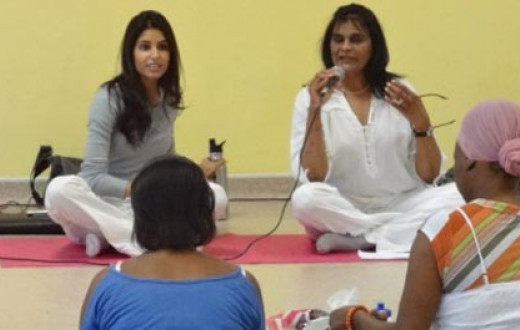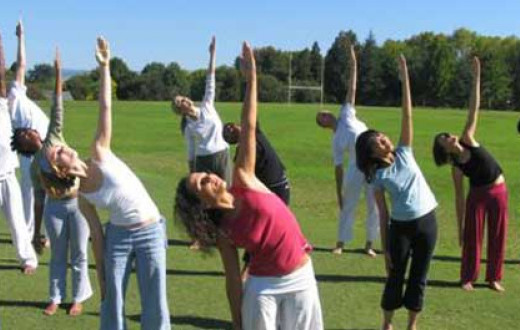Once I asked an ayurvedic doctor about the relationship between yoga and ayurveda. His simple explanation was, “Ayurveda is the science and yoga is the practice of the science.” I have been a health care professional and Sri Sri Yoga teacher for over 10 years now. It has been inevitable that the practice of yoga has led me to understand the science of ayurveda more and the inquiry into the ayurvedic science has inspired me to practice Yoga.
Yoga and ayurveda are inseparable sisters. Both originate as part of a greater system of Vedic knowledge (what I would call as the nurturing mother). Yoga originates in the Yajur Veda, while Ayurveda originates in the Atharva Veda and Rig Veda.
Both yoga and ayurveda are based upon the principles of trigunas (sattva, rajas and tamas) and the panchamahabuthas (earth, air, fire, water, space). Yoga and ayurveda also encompass an understanding of how the body works (Dosha-Dhatu-Mala/humor-tissue-waste material theory) and the effect that food and medicines have on the body (Rasa-Veerya-Vipaka/taste-energy-post digestive effect concept).
Both of these sciences have eight branches: Ashtanga yoga and Ashtanga ayurveda. The two have a common understanding of health of the body being dependent on the health and balance of the mind. They share virtually the same metaphysical anatomy and physiology, which consists of 72,000 nadis (subtle channels), seven main chakras (energy centers), five bodily sheaths and the kundalini shakti (energy).
In treatment, both yoga and ayurveda advocate for the regular practice of pranayama and meditation as well as the use of herbs, body purification procedures, food and chanting of mantras for physical and mental health. In yoga, the body purification procedures have been explained as ‘Satkriyas’ whereas in ayurveda they are known as ‘Panchakarma’.
Both recognize that keeping the body healthy is vital for fulfilling the four aims of life: dharma (duty), artha (wealth), kama (desire), and moksha (liberation).
It is quite a revelation to see how yoga and ayurveda are interrelated. For me, as a yoga instructor, the experience of unveiling the magic of ayurveda can be summarized in this one little phrase:
Yoga is a Yummy, Organic, Great, Adventure!
Exploring Ayurveda
Yummy
For the love of food, I wanted to learn more about why I am attracted to certain foods, how do I feel when I eat them, what gives me cravings, and what does not appeal at all... This ‘yummy’ initiative is what led me to understand ayurveda more. As you may well know, ayurveda embraces the concept ‘ahar’ referring to food. Sri Sri Ayurvedic doctor, Abhishek Kumar, shares that the type of food that we take and the foods one should avoid is determined by your prakriti (inherent body constitution). These choices, alongwith the lifestyle we lead, takes first priority over which ayurvedic medicines are prescribed.
Yoga generally promotes a diet that is sattvic (light and pure) in nature; ayurveda goes into great detail in looking at which foods balance one’s constitution (according to ‘dosha’) and categorizes food according to six tastes (sweet, sour, salty, bitter, pungent, astringent).
Organic
Yoga is believed to be a natural way of healing. The basic principle of ayurveda is based on the shloka: “Yat Pinde Tat Brahmande” (from the Puranas) which means that the microcosm is equal to the macrocosm. In other words, whatever is within us, in our cells, is equivalent to that which is in the universe. This understanding sparked an overwhelming sense of gratitude in me, knowing that every aspect of nature has the answers to good health.
Dr. Farhad Dastur, a social scientist and evolutionary psychologist, eloquently describes this understanding stating that “the love given by the soil, the rain, the air, the sun...is boundless giving that went into creating the plants that we consume.”
Great
Great for me, implies abundance... in practicing yoga, there is an inevitable expansion of feeling, being and acting more positively towards the self, society and the environment. Ayurveda supports this notion of greatness, delving into the intricacies of knowledge on how one can practice their daily routine (dinacharya) and immeasurable remedies for maintaining good health and prevention and treatment of disease. What amazes me, is that, often, nature gives us clues as to what it is good for. For example, the herb that is used to treat bones and joints actually resembles bones and joints of the body and there are several similar examples.
Adventure
The path of yoga is an adventure into the unknown. For me, this definitely relates to my experiences in cleansing processes. In my training, jal nethi (an ancient method used for sinus irrigation), shankarprakshalan (a thorough cleansing technique) were an absolute adventure in getting to know the limitations I had in allowing my body to detox. Venturing into the world of body cleansing, I came to know and understand the ayurvedic body purifying procedures called Panchakarma.
Experiencing these treatments was a phenomenal journey.
I hope that you, too, will tap into the vastness of mother Vedas and discover this beautiful sister relationship of yoga and ayurveda.
By Babeeta Chhabra
(Currently based in Canada, Babeeta Chhabra teaches The Art of Living's Sri Sri Yoga & Sri Sri Natya courses. Needless to say, she is passionate about yoga and ayurveda!)





















































